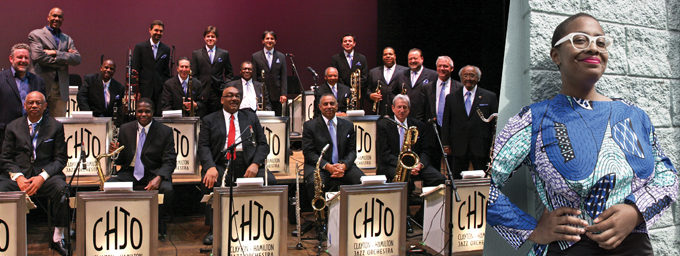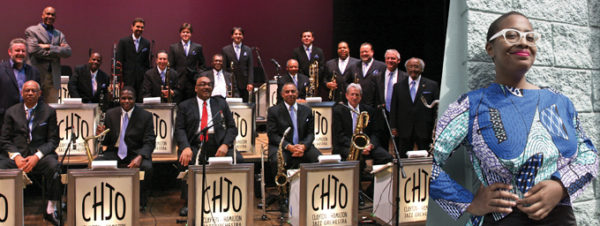CLAYTON-HAMILTON JAZZ ORCHESTRA WITH SPECIAL GUEST CÉCILE MCLORIN SALVANT
MONDAY 5 NOVEMBER
BOLOGNA, TEATRO DUSE, 9:15 PM
Cécile McLorin Salvant , voice; Jeff Clayton , alto sax, arrangements and direction;
John Clayton , double bass, arrangements and direction; Jeff Hamilton , drums, arrangements and direction.
Simple and direct is the definition of the Clayton-Hamilton Jazz Orchestra given by DownBeat: “the best big band in America”. And it does not seem a superlative thrown at random if you scroll the list of artists who have performed or have recorded as soloists with the orchestra: Diana Krall, Nancy Wilson, Dee Dee Bridgewater, Charles Aznavour, John Pizzarelli … List to which is now added Cécile McLorin Salvant, the vocalist who is marking a sort of renaissance in the African-American jazz song. For her John Clayton has created a new set of arrangements specifically for the tour that will also stop at the Bologna Jazz Festival.
Active since 1986, the Clayton-Hamilton Jazz Orchestra collects the best instrumentalists in the Los Angeles area. What is truly unique is the leadership shared by its three founders: Jeff Hamilton and the brothers Jeff Clayton and John Clayton. In the direction as within the orchestral ranks is a strong sense of camaraderie, typical of a large musical family.
Jeff Hamilton, on drums, is a real rhythmic propeller, with invaluable experiences: with Oscar Peterson, Ray Brown, Monty Alexander, Lionel Hampton, Woody Herman, LA4, Ella Fitzgerald, Count Basie Orchestra, Rosemary Clooney, Natalie Cole, Diana Krall, Milt Jackson, Barbara Streisand, Mel Tormé, Benny Carter, Lalo Schifrin, George Shearing, Dr. John, Clark Terry, Harry “Sweets” Edison, Gene Harris … Simply the drummer that the big ones want at their side, and to hear it swing you understand soon the reason why.
Jeff Claytonemerges as one of the leading soloists of the training. Also his jazz pedigree is impressive: he played with Ella Fitzgerald, Woody Herman, Lionel Hampton, Lena Horne, the Count Basie Orchestra under the direction of Basie … But you can hear the sound of his sax even in the songs of popular music icons like Michael Jackson, Madonna, Frank Sinatra, Sammy Davis Jr., Joe Cocker, BB King, Ray Charles …
To John Claytonmerit for the unpredictable and distinctive arrangements that give the typical format of the big band a completely renewed musical aspect compared to tradition. Former member of the Count Basie Orchestra (1977-79), before starting the Clayton-Hamilton Jazz Orchestra, he was principal bass player of the Amsterdam Philharmonic Orchestra for five years. Also in his case the collaborations are innumerable and highly placed: Diana Krall, Paul McCartney, Dee Dee Bridgewater, Queen Latifah, Charles Aznavour, Whitney Houston, Carmen McRae, Quincy Jones …
Cécile McLorin Salvant is the new spearhead of jazz singing deeply anchored in the Afro-American matrix. In just a decade of activity, he has already fully confirmed the prediction made on his New York Times’ Stephen Holden debut: “If there is anyone who can carry on the offspring of the big three – Billie Holiday, Ella Fitzgerald and Sarah Vaughan – it is this young virtuoso “.
Born (in 1989) and raised in Miami, she began studying classical singing, which then continued in France in Aix-en-Provence, where she moved in 2007. It is here that one of her teachers, the saxophonist Jean-François Bonnel , directs it towards jazz and in 2009 sponsors its discographic debut with its group. After just one year from that first unexpected step in jazz music, the Thelonious Monk International Jazz Competition won, the main access door for young talents to the highest levels of professional music. Since then Cécile has released three other albums, winning with them two Grammy Awards for the best vocal jazz disc (in 2016 with For One to Love and in 2018 for Dreams and Daggers ) and two first places in the referendum of critics ofDownBeat (in 2014 with WomanChild and then thanks to Dreams and Daggers ).
In his personal vision of African American music, jazz, vaudeville, blues and folk are closely intertwined. The themes dealt with in songs, often retrieved from forgotten repertoire, are ‘strong’ and allow his voice to exhibit all its interpretive intensity, supported by a large register whose perfect control reveals the classical operatic formation.




No comments